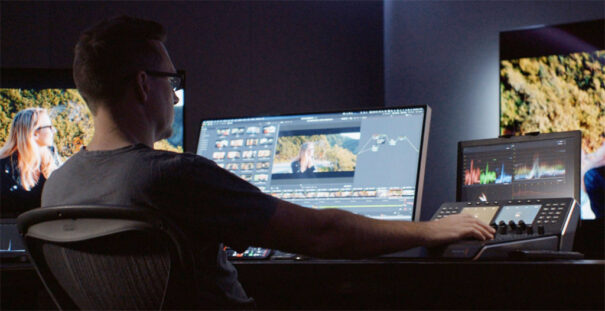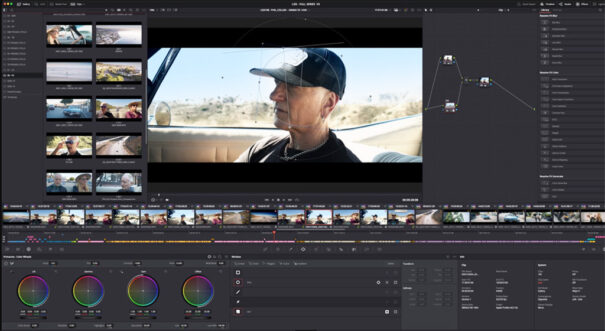Hangman crée un workflow de post-production collaboratif avec DaVinci pour « Life in Six Strings »
Le AXS documentary series ‘Life in Six Strings’ was post-produced by the Hangman team, which decided to establish collaborative workflows based on Blackmagic Design’s DaVinci Resolve software.
In each of the eight episodes of Life in Six Strings, journalist Kylie Olsson presents intimate, candid interviews with world-famous guitarists. The talk show, which takes place in the musicians’ homes or places of interest, has an almost cinematic look and feel that belies the improvisational style of this production. This is due in large part to the aesthetic and post-production work of James Tonkin, founder of the Hangman production company: “I was brought on board by the series’ creator and director [Olsson] as director of photography and to oversee post production. I shot the first two episodes and established the series’ visual tone and style, managing all aspects of post at Hangman, from receiving rushes to delivering the final product.”
Tonkin’s vision was influenced by the film A Star Is Born, for which the director feels a great affinity, which led him to use an anamorphic lens and to capture long shots using a stabilizer, as well as handheld shots. The series also features personal scenes that take place inside cars, which were shot with cameras mounted in a special way so that they did not need to be manipulated. In turn, the production team followed the main vehicle from a secondary one: “It was fast and fluid, all shot over a single day. Kylie wanted to be able to show up at someone’s house, walk in, and chat with them. There wasn’t any time to pre light the house. It had to run seamlessly, very off the cuff, but on screen, it had to look considered and beautiful throughout.”
In the post-production stage of the series, Hangman decided to go with DaVinci Resolve Studio and Blackmagic Cloud, software that allowed Hangman to implement a collaborative work system, whether in editing, color grading or finalizing the material, which was mastered in 4K resolution and delivered in HD definition: “It’s as simple as setting up the project, sending an offline editor a link, and ensuring they have access to the proxy rushes. They can then open the project and effectively see what I’m seeing. (…) On completion, Leigh Brooks, the offline editor, would send me a locked DRT file with the sound set up as an AAF. We had a 22 minute episode that we could conform and start color grading within an hour of receiving the file.”
Pushing the most out DaVinci Resolve’s features
In the final stages of post-production, Tonkin concentrated on color grading, stabilization, aspect ratio adjustment and image enhancement, working directly with the original files in 6K resolution et RED R3D format. Any issues, such as overexposure, were resolved with DaVinci Resolve Studio’s Magic Mask tool: “On the final episode, I had to replace the sky where it had completely clipped in the car. I used the magic mask to identify and separate first the person, and then the sky, and applied another node for sky replacement. This allowed me to add a hue behind what would normally be an overly blown out, white sky.” In addition, the Hangman responsible added a layer of graininess to give the images a warm, analog look, which is in keeping with the theme of this series.
DaVinci Resolve Studio’s artificial intelligence tools also offer an automatic subtitling feature that made the post-production process much more efficient, particularly since the episodes are characterized by dialogue: “Each episode is wall to wall dialogue. However, Resolve’s AI takes three or four minutes to analyze and transcribe that. I watched it through again, checking for any corrections, but it had a greater than 90 percent accuracy rate in my opinion. Previously, when channel delivery requirements dictated closed captions, I’d instantly be writing off time that would otherwise be better spent on creative aspects of the job. But now that that’s under the hood in DaVinci Resolve, it’s something that only takes an extra half an hour of my time.”
Looking back, Tonkin estimates that he spent approximately six hours in post-production on each episode: “I’d first create a 4K master and then export an HD MXF for broadcast delivery to AXS TV. That export, along with the subtitle file and multitracked 14 stems of audio, with delivery through Media Shuttle, was a 10 minute task. We had a great delivery partner with AXS TV, but I also want to credit Kylie who single handedly pulled this together. She can draw great stories from the people that she’s interviewing. The finesse we’ve managed to give it in the grade and the finish has upped the production value, but it’s the content that matters the most.”
As-tu aimé cet article?
Abonnez-vous à notre flux RSS et vous ne manquerez de rien.

















